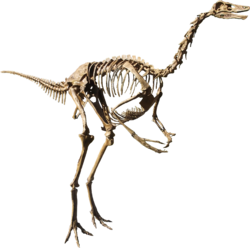
Back ستروثيوميمس Arabic Struthiomimus Catalan Struthiomimus CEB Struthiomimus Czech Struthiomimus German Strutomimo Esperanto Struthiomimus altus Spanish Struthiomimus Basque استروتیومیموس Persian Struthiomimus Finnish
| Struthiomimus Temporal range: Late Cretaceous,
| |
|---|---|

| |
| Cast of an S. altus skeleton, Rocky Mountain Dinosaur Resource Center | |
| Scientific classification | |
| Domain: | Eukaryota |
| Kingdom: | Animalia |
| Phylum: | Chordata |
| Clade: | Dinosauria |
| Clade: | Saurischia |
| Clade: | Theropoda |
| Clade: | †Ornithomimosauria |
| Family: | †Ornithomimidae |
| Genus: | †Struthiomimus Osborn, 1917 |
| Species: | †S. altus
|
| Binomial name | |
| †Struthiomimus altus (Lambe, 1902)
| |
Struthiomimus, meaning "ostrich-mimic" (from the Greek στρούθειος/stroutheios, or "of the ostrich", and μῖμος/mimos, meaning "mimic" or "imitator"), is a genus of ornithomimid dinosaurs from the late Cretaceous of North America. Ornithomimids were long-legged, bipedal, ostrich-like dinosaurs with toothless beaks. The type species, Struthiomimus altus, is one of the more common, smaller dinosaurs found in Dinosaur Provincial Park; their overall abundance—in addition to their toothless beak—suggests that these animals were mainly herbivorous or (more likely) omnivorous, rather than purely carnivorous. Similar to the modern extant ostriches, emus, and rheas (among other birds), ornithomimid dinosaurs likely lived as opportunistic omnivores, supplementing a largely plant-based diet with a variety of small mammals, reptiles, amphibians, insects, invertebrates, and anything else they could fit into their mouth, as they foraged.[1]
- ^ Barrett, Paul M (2005). "The diet of ostrich dinosaurs (Theropoda: Ornithomimosauria)". Palaeontology. 48 (2): 347–358. Bibcode:2005Palgy..48..347B. doi:10.1111/j.1475-4983.2005.00448.x.